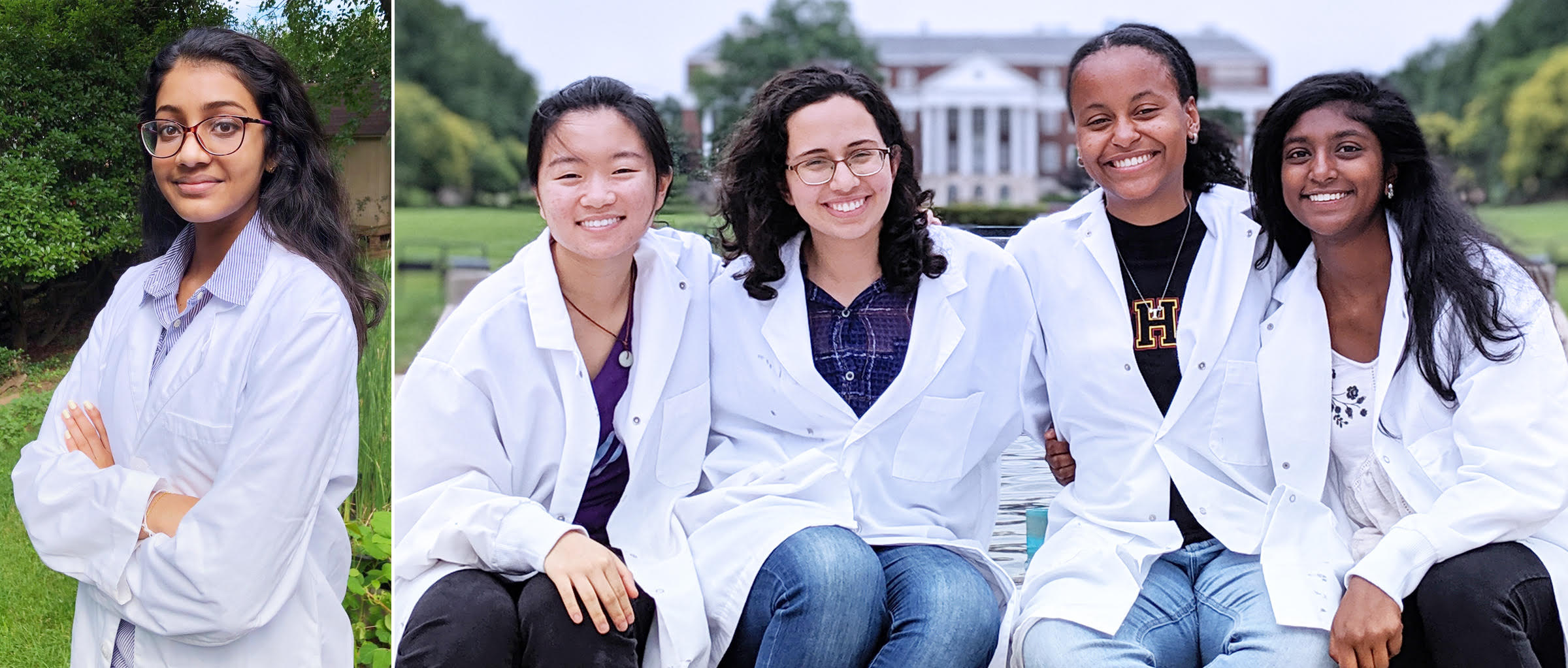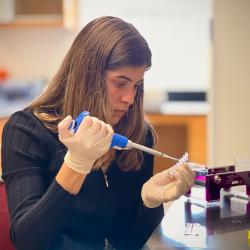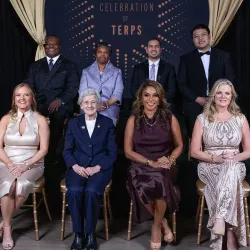Microbiology Experiment from All-female Student Team Heads to Space This Week
The UMD student experiment will test how well bacteria can grow on different surfaces in microgravity aboard the International Space Station
This summer, astronauts on the International Space Station (ISS) will carry out an experiment, designed by five University of Maryland rising sophomores, which will test bacteria’s ability to grow on different surfaces in microgravity. The rocket that will carry the experiment to the ISS is scheduled to launch Wednesay, July 24, 2019.
The experiment is part of the Student Spaceflight Experiments Program (SSEP), which gives students the chance to design and propose real experiments on the ISS. The students’ experiment was selected from numerous proposals by Terps in Space, UMD’s SSEP community, which chooses one team every year to send an experiment to the ISS.
The five students—Debbie Adam, Michelle Fang, Niki Gooya, Swarnapali “Pali” Keppetipola and Apurva Raghu—are all biological sciences majors and members of the Integrated Life Sciences program in the Honors College. Each of them took pride in being a member of an all-female research team.
“I’m extremely proud of our team because the participation of women in science is not as prominent as it should be,” Adam said. “The fact that we have made it this far is really important to me.”
Gooya was the first of the group to enter the space race.
“I participated in SSEP in eighth grade, although my team’s project did not get sent to space,” said Gooya, who attended Burleigh Manor Middle School in Ellicott City, Maryland. “When I found that Maryland participated in the program, I jumped on it and got my friends to join me.”
The students designed an experiment to study slimy layers of bacteria called biofilms. Biofilms stick to each other and to virtually any surface more strongly than a single bacterium can. They are difficult to get rid of and can lead to human illness. Previous research has also shown that biofilms grow more readily in microgravity, making them an important issue to address on the ISS.
The students’ experiment will examine how well biofilms can adhere to both smooth and porous aluminum surfaces in microgravity. Smooth aluminum is solid, whereas porous aluminum has small holes, or pores, throughout its structure. Previous research has shown that bacteria do not stick well to porous aluminum on Earth.
“A lot of equipment on the ISS is made from aluminum, because it’s economical and easy to work with,” Keppetipola said. “For instance, many tubes used in air filters on the ISS are made of aluminum. If biofilms form in the tubing, bacteria could spread into the ISS’ living spaces and make astronauts sick.”
To design their experiment, the students conducted preliminary research with help from Qiao Ding, a graduate student in the laboratory of Rohan Tikekar, assistant professor of nutrition and food science at UMD. The students also acknowledged support from Birthe Kjellerup, assistant professor of civil and environmental engineering at UMD; Timothy Foecke, a scientist at the National Institute of Standards and Technology; and their team mentor, Natalia Stepanova, director of Terps in Space.
“Qiao dedicated so much time to helping us with our project that we consider him an honorary member of our group,” Fang said. “He and so many others took us under their wings and gave us opportunities. I don’t think we could have gotten here without them.”
To test whether bacteria can stick to different aluminum surfaces in microgravity, the students will prepare a tube containing dormant E. coli bacteria and two pieces of aluminum—one porous and one smooth. On the ISS, astronauts will add nutrient solution to the bacteria, triggering their activation and growth. After three days, the astronauts will add a preservative to the bacteria-nutrient mixture to kill the bacteria and freeze the cells in place. At the same time, the students will conduct an identical experiment on Earth for comparison.
The idea of conducting an experiment in parallel with astronauts on the ISS is especially exciting to Raghu. “Ever since I was little, I wanted to be an astrophysicist, although I’m pre-med now,” Raghu said. “This way, if I can’t go to space, I can at least see my tube go to space.”
After the ISS experiment returns to Earth, students will analyze the thickness, area, volume and other physical properties of the biofilms grown on the aluminum surfaces. Their primary goal is to determine which type of aluminum surface better resisted biofilm growth in microgravity. Additionally, they will assess whether biofilms had a higher density, growth rate and bacterial cell count in space than on Earth.
If porous aluminum is indeed resistant to biofilm growth in microgravity, the students suggest that other researchers should study how to incorporate more porous materials on the ISS. This could be especially important in places such as pipes and storage areas, which are most prone to biofilm growth.
Ultimately, the students would like to submit their results for publication.
Editor's Note: A previous version of this story listed the launch date as Sunday, July 19, 2019. The story was corrected after a delay was announced.
###
SSEP is a program of the National Center for Earth and Space Science Education (NCESSE) in the U.S. and the Arthur C. Clarke Institute for Space Education internationally. It is enabled through a strategic partnership with DreamUp PBC and NanoRacks LLC, which are working with NASA under a Space Act Agreement as part of the utilization of the International Space Station as a National Laboratory.
Writer: Irene Ying
Media Relations Contact: Kimbra Cutlip, 301-405-9463, kcutlip@umd.edu
University of Maryland
College of Computer, Mathematical, and Natural Sciences
2300 Symons Hall
College Park, Md. 20742
www.cmns.umd.edu
@UMDscience
About the College of Computer, Mathematical, and Natural Sciences
The College of Computer, Mathematical, and Natural Sciences at the University of Maryland educates more than 9,000 future scientific leaders in its undergraduate and graduate programs each year. The college's 10 departments and more than a dozen interdisciplinary research centers foster scientific discovery with annual sponsored research funding exceeding $175 million.








